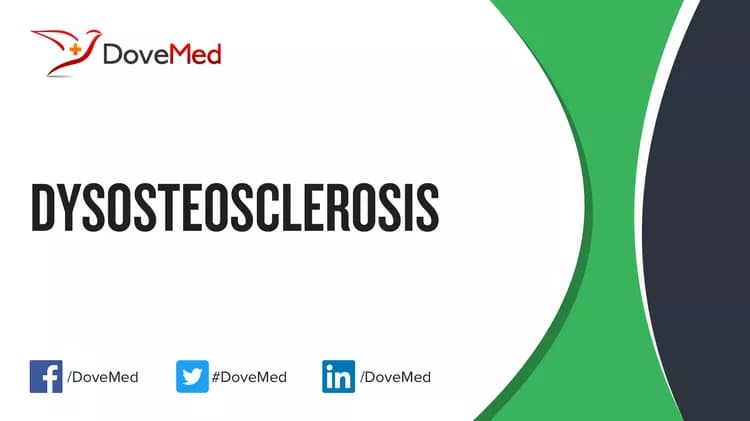What are the other Names for this Condition? (Also known as/Synonyms)
- Autosomal Recessive Dysosteosclerosis
- X-Linked Recessive Dysosteosclerosis
What is Dysosteosclerosis? (Definition/Background Information)
- Dysosteosclerosis is a skeletal dysplasia characterized by progressive osteosclerosis and platyspondyly
- The disease is characterized by sclerosis of the skull base, ribs, clavicles, scapulae, mid-diaphyses and increased bone fragility
- Patients have a prominent forehead, narrow midface, flattening of the vertebral bodies and dental anomalies
- Short stature, optic atrophy, hearing impairment, epilepsy, skin changes, and progressive psychomotor deficit are frequent
(Source: Dysosteosclerosis; Orphanet, National Institute of Health and Medical Research (INSERM), Paris.)
Who gets Dysosteosclerosis? (Age and Sex Distribution)
- Dysosteosclerosis is a rare congenital disorder, and currently, only about 30 cases have been described in the medical literature
- The presentation of symptoms may occur at birth
- Both males and females may be affected
- Worldwide, individuals of all racial and ethnic groups may be affected
What are the Risk Factors for Dysosteosclerosis? (Predisposing Factors)
- A positive family history may be an important risk factor, since Dysosteosclerosis can be inherited
- Children of consanguineous parents may bear an increased risk of being born with this disorder
- Currently, no other risk factors have been clearly identified for Dysosteosclerosis.
It is important to note that having a risk factor does not mean that one will get the condition. A risk factor increases one’s chances of getting a condition compared to an individual without the risk factors. Some risk factors are more important than others.
Also, not having a risk factor does not mean that an individual will not get the condition. It is always important to discuss the effect of risk factors with your healthcare provider.
What are the Causes of Dysosteosclerosis? (Etiology)
- Dysosteosclerosis is caused by mutations in SLC29A33. This gene encodes a nucleoside transporter
- Mutations in this gene may also cause Faisalabad histiocytosis, RosaÔ-Dorfman disease, H syndrome, and pigmented hypertrichosis with insulin-dependent diabetes mellitus syndrome.
- Parental consanguinity has been noted in some cases
- Dysosteosclerosis is inherited in an autosomal recessive manner, but an X-linked pedigree has also been reported.
(Source: Dysosteosclerosis; Orphanet, National Institute of Health and Medical Research (INSERM), Paris.)
What are the Signs and Symptoms of Dysosteosclerosis?
The signs and symptoms of Dysosteosclerosis may vary from one individual to another and may include:
Very frequently present symptoms in 80-99% of the cases:
- Abnormality of dental enamel
- Abnormality of the cranial nerves
- Abnormality of the metaphysis
- Cerebral calcification
- Craniofacial hyperostosis
- Delayed eruption of teeth
- Developmental regression
- Hearing impairment
- Hypertelorism
- Hypoplastic vertebral bodies
- Increased bone mineral density
- Intellectual disability
- Irregular vertebral endplates
- Macrocephaly
- Nystagmus
- Optic atrophy
- Platyspondyly
- Recurrent fractures
- Rough bone trabeculation
- Ventricular septal defect
Frequently present symptoms in 30-79% of the cases may include aplasia/hypoplasia of the skin.
Occasionally present symptoms in 5-29% of the cases:
- Abducens palsy
- Abnormal metaphyseal trabeculation
- Absent frontal sinuses
- Absent paranasal sinuses
- Autosomal recessive inheritance
- Blindness
- Broad femoral neck
- Broad ribs
- Clavicular sclerosis
- Delayed closure of the anterior fontanelle
- Dermal atrophy
- Diaphyseal thickening
- Disproportionate short stature
- Facial paralysis
- Flared metaphysis
- Frontal bossing
- High palate
- Increased intervertebral space
- Increased susceptibility to fractures
- Micrognathia
- Narrow chest
- Narrow iliac wings
- Natal tooth
- Obstructive sleep apnea
- Oligodontia
- Osteopenia
- Parietal bossing
- Premature loss of teeth
- Progressive bowing of long bones
- Prominent forehead
- Round face
- Sclerosis of hand bone
- Sclerosis of skull base
- Sclerotic scapulae
- Seizures
- Short diaphyses
- Short ribs
- Short sternum
(Source: Dysosteosclerosis; Genetic and Rare Diseases Information Center (GARD) of National Center for Advancing Translational Sciences (NCATS), USA.)
How is Dysosteosclerosis Diagnosed?
Dysosteosclerosis is diagnosed on the basis of the following information:
- Complete physical examination
- Thorough medical history evaluation
- Assessment of signs and symptoms
- Laboratory tests
- Imaging studies
- Biopsy studies, if necessary
Many clinical conditions may have similar signs and symptoms. Your healthcare provider may perform additional tests to rule out other clinical conditions to arrive at a definitive diagnosis.
What are the possible Complications of Dysosteosclerosis?
The complications of Dysosteosclerosis may include:
- Severe skeletal defects
- Intellectual impairment
- Severely reduced quality of life
Complications may occur with or without treatment, and in some cases, due to treatment also.
How is Dysosteosclerosis Treated?
There is no cure for Dysosteosclerosis, since it is a genetic condition. The treatment is usually given to manage the signs and symptoms and any complications that develops.
How can Dysosteosclerosis be Prevented?
Currently, Dysosteosclerosis may not be preventable, since it is a genetic disorder.
- Genetic testing of the expecting parents (and related family members) and prenatal diagnosis (molecular testing of the fetus during pregnancy) may help in understanding the risks better during pregnancy
- If there is a family history of the condition, then genetic counseling will help assess risks, before planning for a child
- Active research is currently being performed to explore the possibilities for treatment and prevention of inherited and acquired genetic disorders
Regular medical screening at periodic intervals with tests and physical examinations are recommended.
What is the Prognosis of Dysosteosclerosis? (Outcomes/Resolutions)
- The prognosis of Dysosteosclerosis is dependent upon the severity of the signs and symptoms and associated complications, if any
- Individuals with mild conditions have better prognosis than those with severe symptoms and complications
- The prognosis may be assessed on a case-by-case basis; although, it is mostly poor
Additional and Relevant Useful Information for Dysosteosclerosis:
The following DoveMed website link is a useful resource for additional information:
Related Articles
Test Your Knowledge
Asked by users
Related Centers
Related Specialties
Related Physicians
Related Procedures
Related Resources
Join DoveHubs
and connect with fellow professionals


0 Comments
Please log in to post a comment.